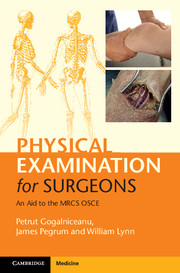Book contents
- Frontmatter
- Dedication
- Contents
- List of contributors
- Introduction
- Acknowledgments
- List of abbreviations
- Section 1 Principles of surgery
- Section 2 General surgery
- Section 3 Breast surgery
- Section 4 Pelvis and perineum
- Section 5 Orthopaedic surgery
- Section 6 Vascular surgery
- Section 7 Heart and thorax
- Section 8 Head and neck surgery
- Section 9 Neurosurgery
- Section 10 Plastic surgery
- 39 Examination of skin lesions and lumps
- 40 Examination of scars
- 41 Examination of flaps and grafts
- 42 Examination of burns
- 43 Examination of the hands
- Section 11 Surgical radiology
- Section 12 Airway, trauma and critical care
- Index
39 - Examination of skin lesions and lumps
from Section 10 - Plastic surgery
Published online by Cambridge University Press: 05 July 2015
- Frontmatter
- Dedication
- Contents
- List of contributors
- Introduction
- Acknowledgments
- List of abbreviations
- Section 1 Principles of surgery
- Section 2 General surgery
- Section 3 Breast surgery
- Section 4 Pelvis and perineum
- Section 5 Orthopaedic surgery
- Section 6 Vascular surgery
- Section 7 Heart and thorax
- Section 8 Head and neck surgery
- Section 9 Neurosurgery
- Section 10 Plastic surgery
- 39 Examination of skin lesions and lumps
- 40 Examination of scars
- 41 Examination of flaps and grafts
- 42 Examination of burns
- 43 Examination of the hands
- Section 11 Surgical radiology
- Section 12 Airway, trauma and critical care
- Index
Summary
Checklist
WIPER
• Good light source. Lesion and loco-regional lymph nodes exposed.
Physiological parameters
• Ask: ‘Where is the lesion?’
• Ask: ‘Is the lesion painful?’
System
• S-E-I-S (Site, External, Internal, Surroundings)
Skin type
• Fitzpatrick classification of skin type
Site
• Location of lesion
• Number of lesions
External features
• Size (in cm)
• Shape:
• smooth or irregular edge
• flat or raised profile
• Surface:
• skin: intact or ulcerated skin, skin adnexae
• colour/pigmentation and telangiectasia
• colour distribution: regular vs. irregular
• discharge: blood, pus, lymph
• Scars from previous surgery (skin lesions or lymphadenectomy)
Internal
• Consistency: soft, hard
• Content: gas (crepitus), fluid (fluctuant and transilluminable), solid (nontransilluminable)
• Dynamic interaction: pulsatile, reducible, indentable, compressible
• Mobility and attachment to surrounding structures (above, below and laterally)
• Percussion: dull or resonant (gas, fluid, solid)
• Auscultation: bruits, bowel sounds
Surroundings
• Assess surrounding skin: normal or satellite lesions.
• Palpate for local, regional, general lymphadenopathy.
• Assess nerves: local and distal sensory and motor functions.
• Assess vascular supply of lesion: capillary refill time and pulses.
• Palpate liver for an irregular edge or enlargement and vertebral spine for tenderness if concerned about metastatic deposits.
Examination notes
Tip
The examination of a lump is very poorly done in general, due to a lack of a systematic or anatomical way of approaching the lesion. Palpation in particular needs to be structured as described above in order to avoid redundant gestures.
What is the system for examining a skin lump?
S-E-I-S:
Skin (type) and Site (inspection)
External features (inspection)
Internal features (inspection and palpation)
Surroundings: skin, local, regional or distal lymph nodes (inspection, palpation and movement)
Tip
Beware the melanoma patient with a prosthetic eye or ear.
What are the principal questions in assessing a skin lesion?
• Where is the lesion located on the body?
• What does the lesion look like externally?
• What is inside the lesion?
• What is the anatomical plane of the lesion?
- Type
- Chapter
- Information
- Physical Examination for SurgeonsAn Aid to the MRCS OSCE, pp. 353 - 358Publisher: Cambridge University PressPrint publication year: 2015

